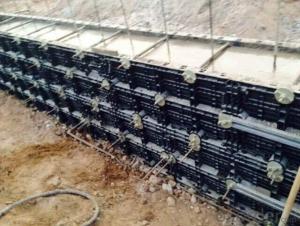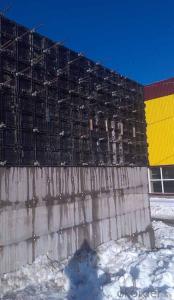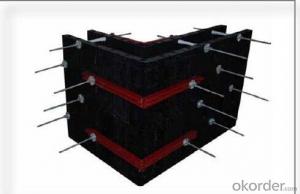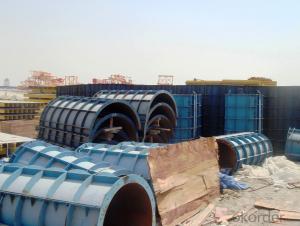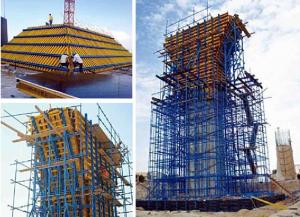New Type of Plastic Formworks Used in Constructions
- Loading Port:
- Shanghai
- Payment Terms:
- TT OR LC
- Min Order Qty:
- 1 m²
- Supply Capability:
- 100000 m²/month
OKorder Service Pledge
OKorder Financial Service
You Might Also Like
1.Main Introduction of PLASTIC FORMWORK:
The biggest panel is 120x60cm, weight only 10.5kg, which can be lift and set up by only one person easily, need no crane on the site.
2. The Advantages of PLASTIC FORMWROK:
-easy set up
Different size of panels can be firmly locked by simply turn the special handles to 90 degree. The panels have rib on the back, which makes the
system need not traditional wood blocks and nails. The panels have holes to fit tie rod, guarantee the strength of the whole system.
-modularity
Modular formwork composed by different size of panels, the main item is 120x60 panel, the size is 120x60cm, which used for the large area of walls
and slabs. There are also small size of panels like 10x60 panel (10x60cm), 20x60 panel (20x60cm), 25x60 panel (25x60cm), inner corner (20x20x60cm) and outer corner (10x5x60cm). Due to the variety of panel size, the system can form almost all size walls120x60 panel (act size 120x60cm) of multiple by 5cm. The material of modular formwork is PC-ABS mixied with special glass fibres which enable panels to hold high pressures.
-strength
The handles are made by high strength Nilon, each panel locked by at least 4 handls, which makes the whole system strong enough to pour 40cm walls.
-enviroment friendly
The system need not cut and nail due to the variety size, and nearly need no wood, the material can be recycled after broken, will not pollute the enviroment.
-consequent
Concrete does not stick to plastic, thus the panels need no oil before using, and can be cleaned simply by water. The surface of the wall which built by modular formwork is smooth, can be left without rework.
3. Images for Plastic formwork:
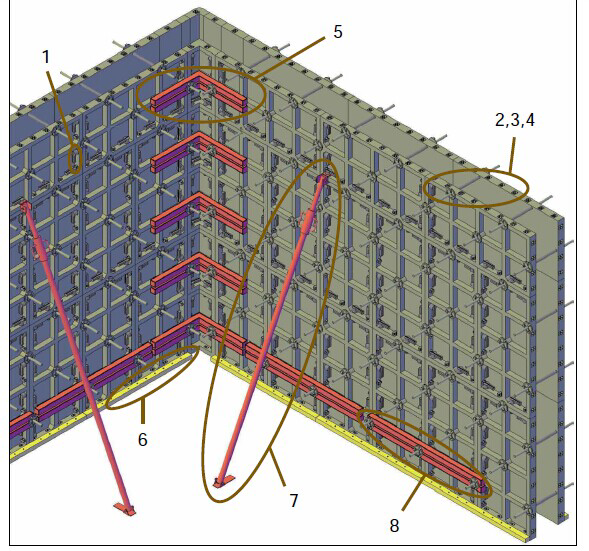
4. FAQ of Plastic formwork
1) What can we do for you?
We can ensure the quality of the vinyl banner and avoid extra expenses for customers.
.We can provide you the professional design team.
.We can provide fashionable and newest styles for you.
.We can design the artwork for you.
. Please feel free to customize.
2) What promises can be done by us?
. If interested in plastic formwork, please feel free to write us for any QUOTE.
. If printing required, please advise asap because the whole set need much more time to complete.
. Please DO check goods when courier knocks your door and contact us asap if any issue.
- Q:Can steel frame formwork be used for both smooth and textured concrete finishes?
- Yes, steel frame formwork can be used for both smooth and textured concrete finishes. The steel frame provides a sturdy and rigid structure that can withstand the pressure of concrete pouring, ensuring a consistent and uniform surface. Additionally, the formwork can be customized with different surface treatments or textures to achieve the desired finish, whether smooth or textured.
- Q:How does steel frame formwork prevent leakage or seepage of concrete?
- The design of steel frame formwork aims to avoid concrete leakage or seepage by creating a tight and secure enclosure for the poured concrete. The steel frame functions as a robust barrier, keeping the concrete in place and preventing it from escaping or seeping out. A distinguishing feature of steel frame formwork is its ability to create a smooth and uninterrupted surface. The steel panels are joined together using sturdy locking mechanisms, leaving no gaps or openings through which the concrete can escape. This strong and secure connection between the panels effectively prevents any leakage or seepage. Furthermore, steel frame formwork is constructed to withstand the pressure exerted by the wet concrete during the pouring and curing process. The steel panels are sturdy and inflexible, ensuring that they can endure the weight and pressure of the concrete without bending or distorting. This structural integrity of the steel frame further guarantees the absence of any leakage or seepage. Additionally, steel frame formwork is often coated with special sealants or coatings that enhance its impermeability. These coatings provide an extra layer of protection against potential leaks or seepage. They establish a waterproof barrier that stops water or moisture from infiltrating the concrete and causing damage. In conclusion, steel frame formwork presents an effective solution for preventing concrete leakage or seepage. Its smooth and uninterrupted surface, structural integrity, and supplementary protective coatings ensure that the concrete remains securely contained within the formwork, resulting in a sturdy and long-lasting structure.
- Q:What are the considerations for selecting the appropriate formwork for different concrete reinforcement requirements?
- When selecting the appropriate formwork for different concrete reinforcement requirements, there are several considerations that need to be taken into account. Firstly, the type and size of the concrete structure being constructed plays a crucial role in determining the formwork requirements. For example, a simple rectangular column may require a different formwork system compared to a complex curved structure. The formwork should be able to provide the necessary support and shape to the concrete during the pouring and curing process. Secondly, the height and load-bearing capacity of the formwork need to be considered. Taller structures may require more robust formwork systems that can withstand the pressure exerted by the wet concrete. Similarly, if the structure will be subjected to heavy loads, the formwork should be able to support the weight without any deformation or failure. Another important consideration is the desired finish of the concrete surface. If a smooth and even surface is required, the formwork should be able to provide the necessary support and prevent any bulging or distortion during the pouring process. On the other hand, if a textured or patterned finish is desired, the formwork may need to incorporate additional elements such as liners or inserts to achieve the desired result. The time constraints of the project also need to be taken into account. Some formwork systems may be easier and faster to assemble and dismantle, allowing for quicker construction times. This can be particularly important in projects with tight deadlines or where construction needs to be completed in phases. Cost is another consideration when selecting formwork. Some formwork systems may be more expensive to purchase or rent initially, but if they can be reused multiple times, the overall cost may be lower compared to one-time-use formwork. Additionally, the cost of labor and equipment required for assembly and dismantling should also be considered. Lastly, safety is of utmost importance when selecting formwork. The chosen formwork system should comply with all relevant safety regulations and standards. It should be able to provide a secure working platform for construction workers and prevent any accidents or structural failures during the concrete pouring and curing process. In conclusion, selecting the appropriate formwork for different concrete reinforcement requirements involves considering factors such as the type and size of the structure, height and load-bearing capacity, desired finish, time constraints, cost, and safety. By carefully evaluating these considerations, the most suitable formwork system can be chosen to ensure successful and efficient concrete construction.
- Q:How does steel frame formwork help in achieving a smooth concrete finish?
- Achieving a smooth concrete finish is made possible with the use of steel frame formwork. This formwork system provides a sturdy and stable structure for pouring the concrete, preventing any sagging or bulging. It ensures that the concrete retains its desired shape and surface finish. The formwork is constructed from top-notch steel, renowned for its strength and durability. This guarantees that it can withstand the pressure exerted by the wet concrete without bending or distorting. Consequently, the concrete sets evenly and smoothly, minimizing any imperfections or irregularities on the surface. Moreover, the steel frame formwork system allows for precise control over concrete placement and compaction. The formwork can be adjusted and aligned to the desired dimensions and angles, ensuring accurate pouring. This eliminates the need for excessive manual finishing or leveling, resulting in a smoother and more consistent finish. Furthermore, the steel frame formwork also minimizes the risk of formwork marks or imprints on the concrete surface. The steel panels used in the formwork are smooth and non-porous, reducing the chances of any texture or pattern transferring onto the concrete. This ensures a clean and uniform appearance of the finished concrete. In conclusion, steel frame formwork is essential for achieving a smooth concrete finish. It provides stability, precision, and minimizes the risk of formwork marks. Its strength, durability, and versatility make it an ideal choice for ensuring high-quality finishes in concrete construction projects.
- Q:What are the key considerations for selecting the appropriate steel frame formwork system for projects with unique architectural features?
- When selecting the appropriate steel frame formwork system for projects with unique architectural features, there are several key considerations that need to be taken into account. These considerations ensure that the chosen system is able to meet the specific requirements and demands of the project, while also providing the necessary support and stability. 1. Flexibility and adaptability: The steel frame formwork system should be able to adapt to the unique architectural features of the project. This includes the ability to adjust the formwork to accommodate irregular shapes, curves, and intricate designs. The system should offer flexibility in terms of panel sizes, heights, and configurations to ensure a perfect fit for the project's requirements. 2. Strength and durability: Projects with unique architectural features often require complex and challenging formwork structures. The selected steel frame formwork system should be able to withstand the loads and pressures exerted by the concrete, ensuring stability and safety throughout the construction process. High-quality materials and construction techniques should be employed to ensure the system's strength and durability. 3. Ease of assembly and disassembly: The formwork system should be relatively easy to assemble and disassemble, even with the unique architectural features of the project. This will help save time and resources during the construction process. The system should have clear instructions and efficient connection mechanisms to facilitate quick and hassle-free installation. 4. Cost-effectiveness: The selected steel frame formwork system should provide value for money, considering the unique architectural features of the project. It should be cost-effective in terms of both initial investment and long-term maintenance. The system should offer reusability and longevity, minimizing the need for frequent replacements or repairs. 5. Safety and quality assurance: Safety is of paramount importance in any construction project. The chosen steel frame formwork system should comply with relevant safety standards and regulations. It should also undergo rigorous quality assurance checks to ensure its reliability and performance. The system should be able to withstand the required loadings and provide a safe working environment for the construction workers. 6. Availability of technical support: Projects with unique architectural features may require specialized technical support and expertise during the design and construction phases. The selected steel frame formwork system should be backed by a reputable manufacturer or supplier who can provide necessary guidance and support throughout the project. This includes assistance in design calculations, formwork planning, and troubleshooting. In conclusion, selecting the appropriate steel frame formwork system for projects with unique architectural features requires careful consideration of flexibility, strength, ease of assembly, cost-effectiveness, safety, and technical support. By addressing these key considerations, the chosen system can ensure the successful execution of the project while maintaining the desired architectural features.
- Q:How does steel frame formwork handle the placement of signage and wayfinding elements within the concrete structure?
- Steel frame formwork provides a versatile and efficient solution for the placement of signage and wayfinding elements within a concrete structure. With its rigid and sturdy structure, the steel frame formwork allows for precise and accurate positioning of these elements. The formwork can be designed to incorporate specific recesses or brackets to securely hold the signage in place during the concrete pouring process. Additionally, the steel frame formwork can be easily adjusted or modified to accommodate changes in signage or wayfinding requirements, ensuring flexibility and adaptability throughout the construction process.
- Q:How does steel frame formwork contribute to the overall durability of a structure?
- There are several ways in which steel frame formwork contributes to the overall durability of a structure. To begin with, steel possesses high strength and resistance to deformation, making it a reliable material for bearing heavy loads and external forces. This strength enables the steel frame formwork to support the weight of concrete during construction, guaranteeing the structure's integrity and stability. Moreover, steel is highly durable and exhibits excellent corrosion resistance. Unlike materials like wood or aluminum, steel does not rot or rust easily, which could weaken the structure over time. This resistance to corrosion ensures that the steel frame formwork remains structurally sound and maintains its strength for an extended period. Furthermore, steel frame formwork offers a high level of precision and accuracy in construction. The rigid and robust nature of steel allows for precise alignment and positioning of the formwork, resulting in accurate and consistent placement of concrete. This precision not only enhances the structure's overall aesthetics but also increases its durability by ensuring proper alignment of all elements, reducing the risk of structural failure. Additionally, steel frame formwork is reusable, further enhancing its contribution to a structure's durability. Unlike traditional formwork materials such as wood, which are often single-use and require frequent replacement, steel formwork can be dismantled and reused multiple times. This not only reduces construction costs but also minimizes waste and environmental impact. The ability to reuse steel formwork ensures that the structure's integrity is maintained throughout its lifespan, even during renovation or repair work. In conclusion, steel frame formwork plays a crucial role in enhancing the overall durability of a structure. Its high strength, corrosion resistance, precision, and reusability make it an ideal choice for supporting concrete during construction and ensuring the long-term stability and structural integrity of the building.
- Q:What are the safety certifications required for steel frame formwork?
- Steel frame formwork typically requires several safety certifications to ensure its safety, durability, and performance. Some common certifications for steel frame formwork include: 1. ISO 9001: This certification guarantees that the manufacturer has implemented a quality management system that includes safety processes and meets customer requirements. 2. OSHA compliance: In the US, the Occupational Safety and Health Administration (OSHA) establishes safety standards for construction sites. Steel frame formwork must adhere to OSHA regulations to ensure worker safety. 3. EN 12812: This European standard outlines performance requirements and design methods for steel frame formwork. It covers aspects such as load-bearing capacity, stability, and durability. 4. ANSI/ASSE A10.9: This American National Standard establishes safety requirements for concrete and masonry construction, including formwork. Compliance with this standard ensures that steel frame formwork is safely designed, erected, and used. 5. CE marking: This marking indicates that the steel frame formwork meets essential health and safety requirements set by the European Union. It demonstrates compliance with relevant European directives and conformity assessment procedures. 6. Australian Standards: In Australia, steel frame formwork must comply with applicable Australian Standards, such as AS 3610 for formwork and AS 4100 for steel structures. These standards ensure the safety and quality of the formwork. These safety certifications provide assurance that the steel frame formwork has been manufactured and designed to meet specific safety standards, protecting workers and ensuring the construction project's structural integrity.
- Q:What are the different types of scaffolding systems used with steel frame formwork?
- There are several different types of scaffolding systems that are commonly used with steel frame formwork. These systems are designed to provide support and stability to the formwork structure, ensuring the safety of workers and the successful completion of the construction project. One type of scaffolding system used with steel frame formwork is the traditional tube and coupler system. This system consists of vertical tubes, horizontal tubes, and couplers that connect and hold the tubes together. It is a versatile and widely used system that allows for easy adjustment and can be adapted to various heights and configurations. Another common type is the modular scaffolding system, which is also known as the frame scaffolding system. This system consists of prefabricated frames that can be easily assembled and disassembled. It is lightweight and provides a stable and secure platform for workers. Cuplock scaffolding is another popular choice. It is a system that uses vertical standards with a series of cups that lock together to create a secure connection. It is known for its speed of assembly and versatility, as it can be used for both straight and curved structures. Ringlock scaffolding is another commonly used system with steel frame formwork. It features vertical standards with ring-shaped connectors that allow for quick and easy assembly. This system is highly flexible and can be used for various applications, including complex structures. Additionally, there are systems such as H-frame scaffolding, which consists of horizontal and vertical steel frames connected by cross braces, and Kwikstage scaffolding, which is a modular system that uses prefabricated components with wedge connections. Overall, the different types of scaffolding systems used with steel frame formwork offer various advantages and suitability for different construction projects. The choice of system depends on factors such as the project requirements, site conditions, and the preferences of the construction team.
- Q:How long does it take to assemble steel frame formwork?
- The time it takes to assemble steel frame formwork can vary depending on the complexity of the project and the experience of the workers involved. However, in general, it can take anywhere from a few hours to a few days to complete the assembly process.
1. Manufacturer Overview |
|
|---|---|
| Location | |
| Year Established | |
| Annual Output Value | |
| Main Markets | |
| Company Certifications | |
2. Manufacturer Certificates |
|
|---|---|
| a) Certification Name | |
| Range | |
| Reference | |
| Validity Period | |
3. Manufacturer Capability |
|
|---|---|
| a)Trade Capacity | |
| Nearest Port | |
| Export Percentage | |
| No.of Employees in Trade Department | |
| Language Spoken: | |
| b)Factory Information | |
| Factory Size: | |
| No. of Production Lines | |
| Contract Manufacturing | |
| Product Price Range | |
Send your message to us
New Type of Plastic Formworks Used in Constructions
- Loading Port:
- Shanghai
- Payment Terms:
- TT OR LC
- Min Order Qty:
- 1 m²
- Supply Capability:
- 100000 m²/month
OKorder Service Pledge
OKorder Financial Service
Similar products
New products
Hot products
